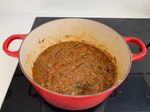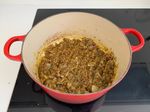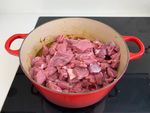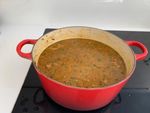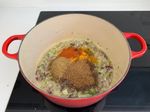With thanks for the recipe to Parin Lad and his "Lockdown Curry School"
←
→
Page content transcription
If your browser does not render page correctly, please read the page content below
with thanks for the recipe to Parin Lad and his
"Lockdown Curry School"
Serves 4 - 6
❖ All quantities are approximate - feel free to change according to taste (the only one you can
overdo is the salt)
❖ Scale up the quantities of all ingredients if you want to make a larger curry than what is listed
here…. remember to adjust the cooking times up accordingly too (especially for the meat dishes)
❖ All “optional” ingredients are not essential
❖ The pictures shown here are to reflect the part in the process but will not represent the
quantities in this recipe (the curry I made with the pictures was huge!)
Step Up required:
● 1 medium sized pan / heavy base / non-stick if possible
● 1 ring on Hob (gas / electric / induction are all fine)
● Chopping board + sharp knife
INGREDIENTS:
STEP 1 - Ingredients (for “onion base”)
● 3 tbsp sunflower oil (any other oil is also fine...vegetable / rapeseed etc)
● 1 large onion - chopped fairly fine
● 2 tsp (heaped) garlic - minced (preferred) or finely chopped
● 1 tsp (heaped) ginger - minced (preferred) or finely chopped
● 1 tsp green chillies - OPTIONAL (depending on if you want some heat)
● 1 large cinnamon stick - OPTIONAL
● 5 cloves - OPTIONAL
STEP 2 - Ingredients (for “spice and tomato base”)
● Spices
○ 1 tsp turmeric powder
○ 2 tsp coriander seeds - ground
○ 2 tsp cumin seeds - ground
○ 3 tsp garam massala
○ 1 tsp chilli powder
● 1 tbsp Salt (or to taste)
● Tomatoes - ½ can of tinned Plum tomatoes or 3 - 4 large ripe tomatoes● 2 tbsp Fenugreek (“Methi”) - dried (“Kasuri Methi”) or fresh / frozen - OPTIONAL
STEP 3 - Ingredients - (your main ingredient) - choose one of these (cooking times will vary for each)
● Chickpea and Potato Curry
○ 1 x 400g can of chickpeas / kala chana
○ 2 medium sized potatoes - cut into 1cm cubes / pieces
○ COOKING TIME = 45 mins
● Chicken curry
○ 8 Chicken thighs - meat removed from bone / 4 medium sized chicken breasts -
chopped into small pieces / 8 chicken legs
○ COOKING TIME = 1 HOUR
● Lamb curry
○ 750g - lamb shoulder and / or leg meat
○ Small chunks of meat is possible, bones are fine to include too
○ Trim excess fat where possible
○ COOKING TIME = 2 HOURS
● Lamb mince curry (“keema”)
○ 500g of lamb mince
○ 2 handfuls of frozen peas (to add 10 mins before cooking end)
○ COOKING TIME = 1.5 HOURS
● Fish Curry
○ 4 fillets of meaty, white fish (cod, haddock, coley, tilapia, pollock will all work) - either
fresh or frozen (defrost obviously!)
○ Or 1 x 400g of tinned fish (Pilchards work really well!)
○ COOKING TIME = 5 - 10 MINS
STEP 4 - Final ingredients to taste
● Fresh Coriander - a decent handful
● Additional garam masala
METHOD:
STEP 1 - Onion base
1. Put oil into the pan along with the cloves and cinnamon (if using) and put on a low to medium
heat for 2 - 3 mins
2. Add the onions and stir so they are coated with the oil
3. Leave onions to cook for 5 - 10 mins until they become translucent and slight brown at the
edges
4. Add the garlic, ginger and fresh chilli (if using) and stir in and then continue to cook for another
2 - 3 minsSTEP 2 - Tomato and spice base (this is the time to be most attentive to your curry!)
5. Add all the spice ingredients and stir together well - ensure your spices do not start sticking to
the pan. If they do, turn down / take off the heat and add a splash of water
6. Add the salt and stir in
7. Let the spices infuse for about 1 minute again ensuring they don’t stick or burn -
burnt spices can ruin a curry, so be careful here!
8. Add the tomatoes and stir in well (if from a tin, break the down with a spoon)
9. Add the fenugreek (if using) and stir in10. Cover the pan and let that cook for a further 5 mins on a low heat - stirring once or twice
during this time to break down the tomatoes and check the consistency of the sauce (again, if
looking dry, add a little water)
11. The mixture should form a nice paste that will be the base of your curry - some oil should still be
visible and that’s fine but if it looks excessive you can drain some off. If the mixture looks too dry
or clumpy then add some water
12. At this stage, you can test the mixture if you like and adjust if you need…
a. If you feel it needs a little more spice, salt or heat then feel free to add
b. If you feel it has a little extra spice, salt or heat - then don’t worry too much it will
mellow a little through the cooking process / additional of water etc
c. If you feel it has way too much extra spice, salt or heat...oh dear! Start preparing some
kind of yoghurt dip or you could add some more tomatoes or you can add some potatoes
to your dish (if it doesn’t already have them) as this will relax the heat out a little
**At this point, as you’ve made the basic curry base, you could take off the heat, allow to cool and
then pick up from Step 3 later (don’t leave it for more than a few hours unrefrigerated though).
Alternatively, once cooled you can also freeze for use at a later stage - again, picking up from Step 3,
once you have defrosted and heated up again**
STEP 3 - Adding the main ingredient
13. Add in all of your main ingredients in one go and give it a good stir around to ensure it’s well
coated in the mixture
a. If using fish, be a bit more careful, as you don’t want to break the fish down. So place
the fish in the pan and gently spoon some of the mixture on top (and swirl the pan in a
circular motion) to get the fish as covered as much possible
14. After a few minutes give it another stir and then cover and keep on a low to medium heat and
this will allow it to generate some moisture (leave for about 10 - 15 minutes)
a. If using fish, then just allow 2 -3 minutes and then turn the fish over, cover withsome of the sauce and cover and leave for another few minutes, after which time it
should be done
15. Then give a stir again and if a good amount of moisture has developed to cover the meat (as
pictured) then cover and leave. If not, add some water to cover the ingredients fully.
16. Essentially, now you need to leave for the cooking times stated on a low to medium heat. At
regular intervals (every 15 minutes at least), give it a good stir and ensure that it is not sticking
at the bottom of the pan. Add water at any stage if you need.
17. If you want to add any potatoes, then add them in when you have at least 30 minutes cooking
time left
STEP 4 - Final ingredients to taste
18. About 5 minutes before the end of the cooking time, add the coriander and stir in (you may
want to set a little bit aside as garnish to add to curry at the end)
19. Also, you can check for taste here (and if cooking meat - especially lamb, check it’s tender to
the bite). Check for salt and spice. If lacking you can add some more in - use some additional
garam masala for spice (another teaspoon or so).
STEP 5 - Enjoy your curry!!
STEP 6 - And please post your photos and videos online using #StayHomeSundaySupperYou can also read





